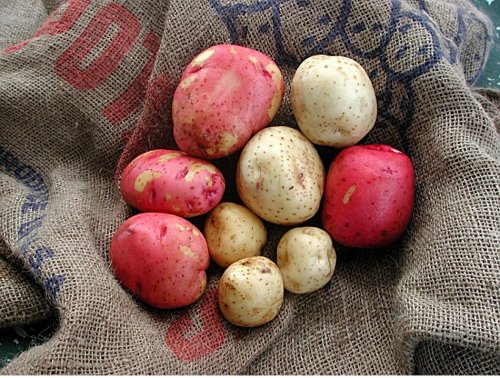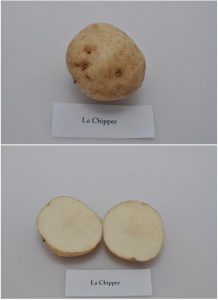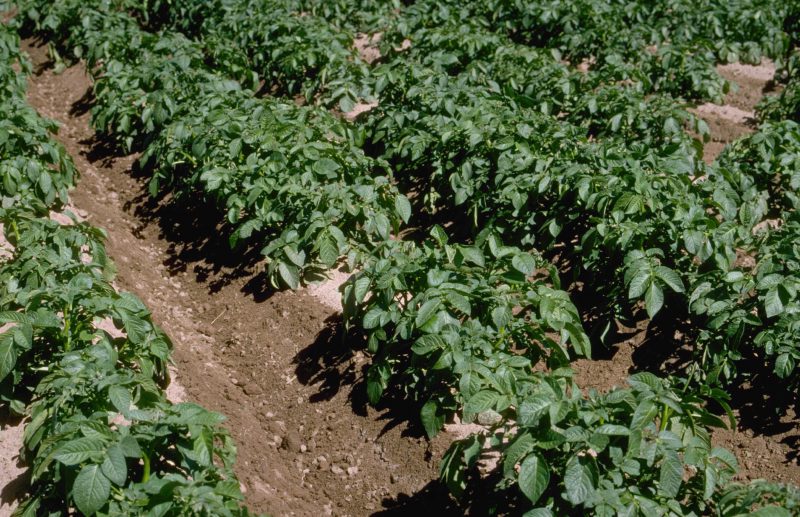
There are both red-skinned and white-skinned potato varieties that grow well in Florida, if planted properly. Photo by C. Hutchinson, UF/IFAS.
Growing Potatoes
It is almost Valentine’s Day, and that means it is potato planting season. Although potatoes are susceptible to frost and freeze damage, hot weather makes them vulnerable to pests and disease, so it is best to take your chances and plant them while love is in the air and temperatures are still mild.
Potatoes (Solanum tuberosum) belong to the Solanaceae family, which also includes crops such as tomatoes, peppers, and eggplant. They prefer soil that is deep, loose, slightly acidic, and rich in organic matter. The area should be well-drained to prevent waterlogging, which can cause potatoes to rot.
Potatoes are heavy feeders, so it is recommended to fertilize with 200 to 230 lb/ac nitrogen, half of which is applied into the bed prior to planting, followed by one or two side-dress fertilizer applications at emergence and/or tuber initiation. Depending on soil test results, phosphorus applications range between 45 to 100 lb/ac of P2O5 and potassium applications range between 170 to 235 lb/ac of K2O.

The tuber and internal flesh color of the potato variety LaChipper. Photo by Lincoln Zotarelli, UF/IFAS.
Potatoes are typically grown from “seed potatoes,” which are pieces of mature potatoes that sprout new plants from the “eyes.” Choose a potato variety that is suited for our climate, such as red-skinned varieties Red LaSoda, Red Pontiac, or LaRoude, or white-skinned varieties such as Yukon Gold, LaChipper, Gold Rush, Sebago, or Kennebec.
A couple days before planting, cut the seed potatoes into 2.5 to 3 oz small pieces (about the size of an egg), making sure each piece has at least one “eye” or sprout. After cutting, let them dry in a cool, dark location for one to two days. In full sun, space the seed potatoes six to eight inches apart in the row and at least 36 inches between rows to a depth of four to five inches.
When the plants are about six inches tall, you can begin “hilling” or mounding soil around the base of the plants to protect the developing tubers from reaching the soil surface. Hilling helps keep the tubers from turning green and becoming bitter due to exposure to light.

When the potatoes are six inches tall, you can begin “hilling” the plants to protect the developing tubers. Photo by Howard F. Schwartz, Colorado State University, Bugwood.org.
–
Potatoes are usually ready for harvest in May, or about 80 to 115 days after planting, depending on the variety. When the leaves on the plant begin to yellow and die back, remove the tops, and allow the potatoes two to three weeks to mature in the ground before digging. This will toughen the skins so they cannot be easily removed, allowing for longer storage.
When harvesting, it is best to dig below the potatoes with a potato fork and lift upward. Cure the potatoes in a cool (60 to 65°F), dark location that is well ventilated for several weeks to allow any bruises or cuts to heal. If stored properly, potatoes can be kept for three to six months.
Potatoes are susceptible to a number of diseases, including late blight (Phytophthora infestans) and early blight (Alternia solani). To help prevent these diseases, rotate your crops every year, choose disease-resistant varieties, and practice good hygiene by removing any infected plants promptly.
So, get ready to spread the love of potato farming this Valentine’s Day with a well-aimed cupid’s arrow in the form of a seed potato in the soil. For more information on potatoes and potato varieties for our area, see the University of Florida Potato Variety Trials Spotlight publications (https://edis.ifas.ufl.edu/entity/topic/potato_varieties).
- Choosing the Right Sales Model for Your Small Farm - July 31, 2025
- Specialty Peppers for Every Heat Level - January 31, 2025
- Understanding Short-Day vs. Long-Day Onions - July 26, 2024
